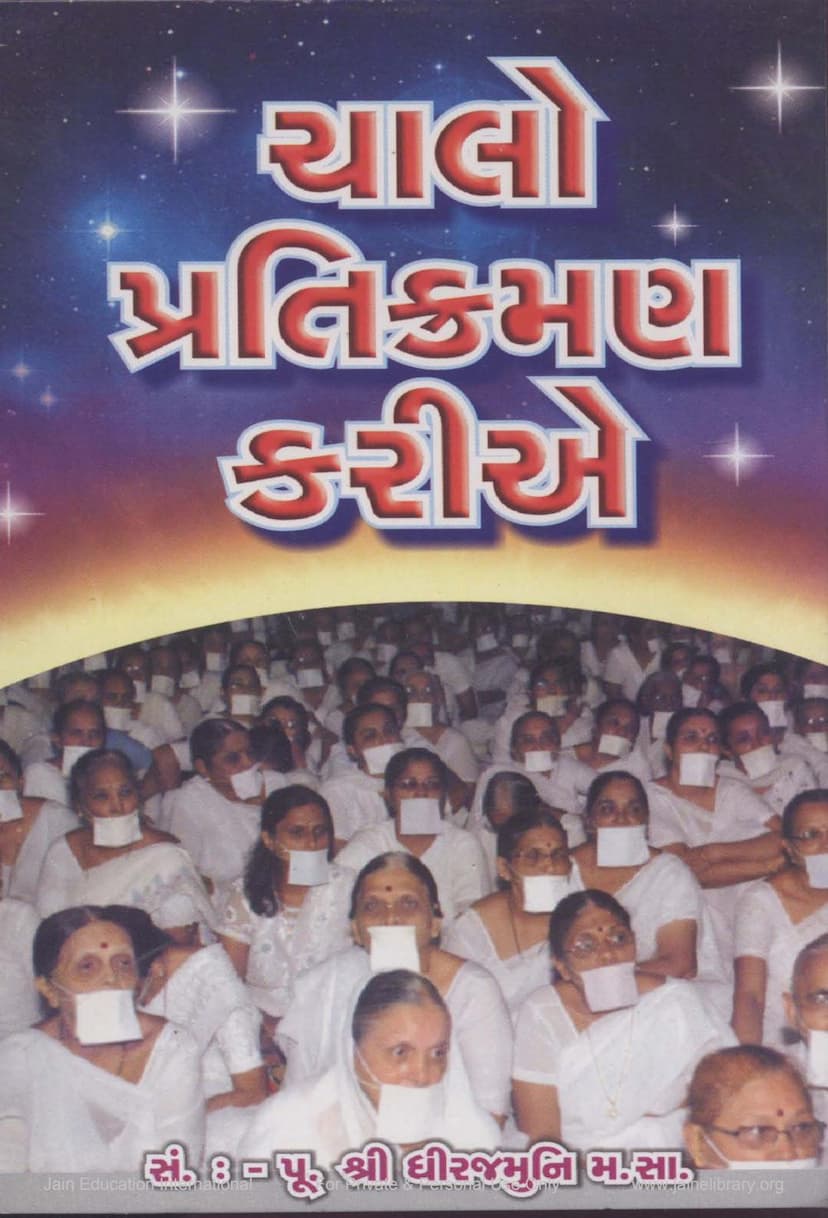Chalo Pratikraman Karie
Added to library: September 1, 2025

Summary
This document is a Gujarati-language Jain text titled "Chalo Pratikraman Karie" (Let Us Do Pratikraman), compiled and edited by Dhirajmuni. The book is published by P M Foundation.
The core purpose of the book is to guide individuals through the practice of Pratikraman, a fundamental ritual in Jainism involving confession, repentance, and purification of the soul.
Here's a summary of its key themes and content:
1. Importance and Purpose of Pratikraman:
- The book begins by addressing a common question from seekers: Is there a way to attain liberation (moksha) for those caught in worldly attachments?
- The answer highlights that Lord Mahavir Swami prescribed the binding of Tirthankar Nam Karma by performing Pratikraman with devotion twice daily.
- Pratikraman is presented as a way to wash away sins committed knowingly or unknowingly, whether intentionally by the ignorant or passively by the knowledgeable.
- It is described as an "amrit kriya" (nectar-like action) that stabilizes the soul from a misplaced state back to its true, pure state.
- The book emphasizes that Pratikraman purifies faults and defects.
2. Structure and Content:
- The text introduces Pratikraman as the 32nd scripture in the 32 Jain Agamas, also known as the Aavashyak Sutra.
- It presents the Samayik Pratikraman Sutra with detailed rituals and explanations, compiled in clear, easy-to-read Gujarati script.
- The book aims to be accessible even for those who haven't memorized Pratikraman, encouraging them to simply read along.
- The text then systematically lays out the various Sutras (verses/chapters) involved in the Pratikraman ritual, including:
- Namaskar Mantra: Salutations to the five supreme beings.
- Guru Vandana Sutra: Reverence to spiritual teachers.
- Aalochana Sutra (Repentance): Confession of sins and faults, detailed over numerous pages (covering specific offenses related to mind, speech, and body, including various types of transgressions like atikram, vyatikram, atiachar, and anachar).
- Tass Uttari Sutra: Verses for expiation and purification.
- Logas Sutra: A hymn praising the Tirthankaras.
- Pratigna Sutra: Vows and commitments.
- Namotthuna Sutra: Further salutations and praises.
- Samapti Sutra: Concluding verses.
- Detailed explanations and recitations for Devasik Pratikraman (daily Pratikraman) and Ratri Pratikraman (nightly Pratikraman).
- Various Aavashyaks (essential practices) are elaborated upon, including Samayik, Pratikraman, Vandana, Kaussagga, and Pachchakhan (fasting/vows).
- Specific sections address various types of sins and their atonement, covering a wide range of faults related to different vows and principles of Jainism.
- The text details the 18 Papasthanas (places of sin) and the 25 types of Mithyatva (false beliefs).
- It explains the significance of Dharma Dhyan (meditation on virtue) with its four types: Ana Vijay, Avay Vijay, Vivad Vijay, and Sansthan Vijay.
- The Pachchakhan Aavashyak section provides the procedures for taking and completing various types of vows like Navkashi, Porisi, Ekasanu, Ayambil, and Upvas.
3. Spiritual Significance and Metaphors:
- The book uses evocative metaphors to describe Pratikraman:
- An "amrit kriya" that stabilizes the soul.
- An "aaina" (mirror) that shows the self.
- A "punita gangotri" (sacred Ganges) of penance.
- A "visarjan" (dissolution) of transgressions.
- The "navnit" (butter/essence) of spiritual practice.
- A "sadhanan shuddhi" (purification of life).
- An "aushadhi" (medicine) for the disease of the soul.
- An "aashan" (acceptance) of the supreme being's command.
- A "safai" (cleaning) of the soul's house.
- A "rest house" for the four pillars of Jainism (monks, nuns, laymen, laywomen).
- A "visamo" (respite) for a householder's life.
- An "operation" for purifying faults.
- A "tablet" for the Pachchakhan ritual.
- A "laundry" for washing sins.
- An "admission" of virtues.
- A "master key" to liberation.
- An "unusual brush" for soul purification.
4. Target Audience and Approach:
- The book is designed for "jignasu" (seekers) who are trapped in the web of worldly attachments.
- It aims to make the practice of Pratikraman accessible to everyone, regardless of their prior knowledge.
- The encouraging message is that "the game is not lost, still there is hope."
In essence, "Chalo Pratikraman Karie" is a comprehensive guide to understanding and performing Pratikraman, emphasizing its spiritual importance and its role in purifying the soul for the ultimate goal of liberation in Jainism. It provides the necessary prayers, rituals, and explanations in a clear and devotional manner.